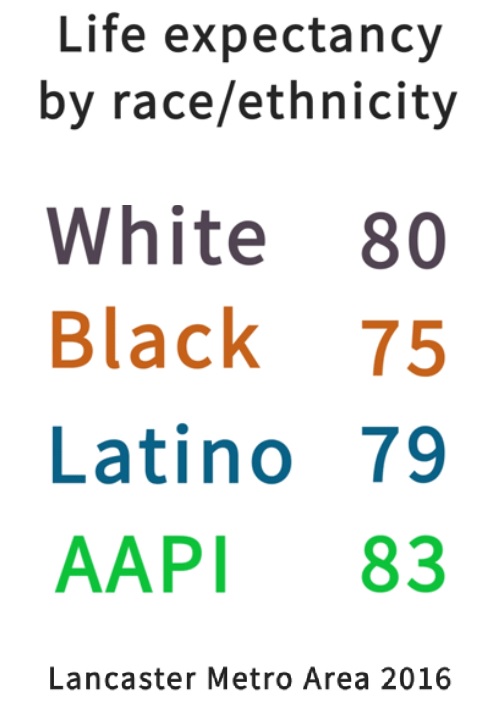Hospitals in three local health systems are participating in a state incentive program that seeks to reduce disparities in medical care for Black and Latino patients.
Over this year and next, Lancaster General Hospital, UPMC Lititz Hospital and WellSpan Ephrata Community Hospital will be tracking preventable admissions and other metrics against benchmarks established in 2022.
Along with other hospitals statewide, they will be paid from a pool of $30 million based on how much they improve their outcomes.
The effort is part of Pennsylvania’s Hospital Quality Incentive Program, or HQIP, which is overseen by the Pennsylvania Department of Human Services.
“HQIP is part of DHS’ ongoing work to reduce disparities and build equity in healthcare for underserved Pennsylvanians, especially in communities of color,” spokesman Brandon Cwalina said.
Social disparities create health disparities
The Covid-19 pandemic and the Black Lives Matter movement both focused attention on the ways in which race, ethnicity and poverty affect health and access to health care.

Health and health disparities are covered in the Lancaster County Racial Equity Profile. Its lead finding: Black life expectancy is lower than that for any other demographic group: 75 years, versus 80 years for White residents.
It notes disparities in health insurance: 34% of Black and 39% of Latino residents in Lancaster Couty are covered by public health insurance, versus 16% of Whites.
Penn State Health’s community health assessment found that Black and Latino households are more likely not to have health insurance at all.
WellSpan Health’s community health assessment found that Black and Latino patients in its service area are more than twice as likely to experience food or housing insecurity.
Nationally, “racial and ethnic minority groups … experience higher rates of illness and death across a wide range of health conditions,” according to the U.S. Centers for Disease Control & Prevention.
“To build a healthier America for all, we must confront the systems and policies that have resulted in the generational injustice that has given rise to racial and ethnic health inequities,” the CDC says.
‘Keep them healthy’
The conditions the hospitals are being asked to focus on include asthma, diabetes, chronic obstructive pulmonary disorder or COPD, and heart failure.
LGH sees diabetes and heart failure as offering the biggest opportunity for progress, Health Promotion Specialist Brenda Buescher said.
Accordingly, staff will be focusing on “how can we prevent those conditions, help people manage those conditions and keep them healthy and out of the hospital.”
LGH is collecting internal data to understand admission disparities, including information on social determinants of health such as housing stability and access to nutritious food.
The hospital will also seek input from a community advisory board that it is in the process of recruiting.
By the summer, LGH hopes to have enough data to come up with some interventions, Buescher said. It plans to run them past the community advisory board. Assuming they pass muster, they would then be piloted and evaluated.
Each idea would be put through a series of “rapid quality improvement cycles,” hopefully yielding a robust model for intervention that can be adapted and used more broadly, Buescher said.
WellSpan advisors meet next week
Comparable initiatives are under way at UPMC Lititz Hospital and WellSpan Ephrata Community Hospital, health system representatives said.
As part of WellSpan’s HQIP effort, it, too, has convened a community advisory group, with members from across its footprint. Its first meeting is set for Wednesday next week, spokesman Ryan Cole said.
Penn State Health Lancaster Medical Center is not formally participating this year. Because it opened in September, less than six months ago, it doesn’t have the full 2022 benchmark data it would need.
The hospital is currently developing its community health strategy, spokeswoman Barbara Shindo said.
“We are dedicated to reducing racial and ethnic health disparities,” she said, and working on “how we begin to positively impact this need in the coming years.”
Community health
Representatives of all four health systems stressed that their participation in Pennsylvania’s HQIP is just one aspect of their own internally driven efforts to reduce health disparities, address social determinants of health and deliver first-class care to marginalized communities.
“This isn’t new,” said Tina Nixon, vice president of mission effectiveness and chief diversity officer for UPMC’s central Pennsylvania region, which includes UPMC Lititz Hospital.
She cited initiatives such as transportation vouchers, language access and resource navigation assistance. UPMC Lititz also supports Patients R Waiting, a local nonprofit devoted to increasing the number of medical practitioners of color as a strategy to eliminate health disparities.
Those efforts are part of UPMC’s community health improvement plan. All four health systems have them, and they’re updated every few years. The current drafts stress reducing health disparities and promoting mental health.
“Our goal is to help ensure that each person in Lancaster County has an equal opportunity for good health,” LG Health writes in its plan. For that to happen, it says, “we must design interventions that serve the people most at risk.”






